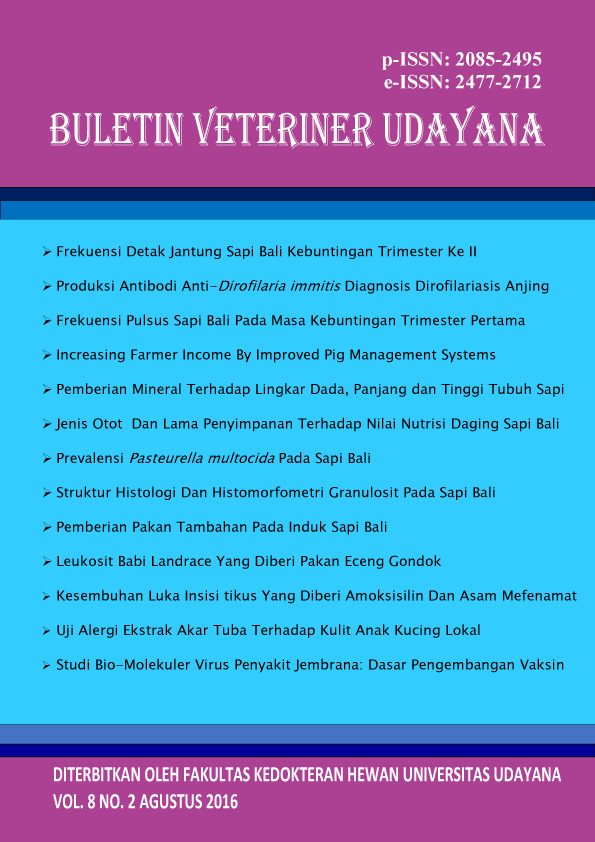TOTAL AND DIFFERENTIAL LEUCOCYTES OF LANDRACE SWINE WERE GIVEN FEED WATER HYACINTH (Eichornia crassipes) FROM LEAD (PB) POLLUTED WATER
Abstract
The aim of this study was to determine the effect of water hyacinth (Eichornia crassipes) collected from Lead (Pb) polluted water in feed total and differential leukocyte counts of pigs. This study was an experimental study and done used a completely randomized design. The sample that been used was blood from a total of eight Landrace swines, consisted of four groups: pigs were feed without hyacinth (A), pigs were feed with 2,5% hyacinth (B), pigs were feed with 5% hyacinth (C), and pigs were feed with 7,5% hyacinth (D). Blood were then collected from auricularis superficialis vein. The total and differential leukocytes were checked in the Clinical Pathology Laboratory, Faculty of Veterinary Medicine, Udayana University. Total leukocytes count were measured by auto analyzer Scil Vet ABC (ABC Vet 16p). The blood were also processed for blood smear preparation by Giemsa staining before performing examination by using 100x magnificence under a microscope using straight edge method. Data were then analyzed by one-way ANOVA. The results showed that the administration of water hyacinth (Eichornia crassipes) collected from Lead (Pb) polluted water was not influence the total and differential leukocyte counts in pigs.
Downloads
References
Darmono. 1995. Logam Berat dalam Sistem Biologi Makhluk Hidup. UI-Press. Jakarta.
Dharmawan NS. 2002. Pengantar Patologi Klinik Veteriner, Hematologi Klinik. Pelawa Sari, Denpasar.
Kataranovski M, Jankovic S, Kataranovski D, Stosic J, Bogojevic J. 2009. Gender differences in acute cadmium-induced systemic inflammation in rats. Biomedical And Environmental Sci. 22(1): 1-7.
Kusnoputranto H. 2006. Toksikologi Lingkungan, Logam Toksik dan Berbahaya. FKM-UI Press dan Pusat Penelitian Sumber Daya Manusia dan Lingkungan. Jakarta.
Kusumadewi MR, Suyasa WB, Berata K. 2015. Tingkat biokonsentrasi logam berat dan gambaran histopatologi ikan mujair (Oreochromis mossambicus) yang hidup di perairan tukad badung kota Denpasar. J Ecotrophic. 9(1): 25-34.
Mannem P. 2014. Lead Toxicity on hematological changes and amelioration with ginger (Zingiber officinale) extract in male albino rats. Int J Advanced Res. 2(4): 23-28.
Onasanya GO, Oke FO, Sanni TM, Muhammad AI. 2015. Parameters influencing haematological, serum and bio-chemical references in livestock animals under different management systems. J Vet Med, 5: 181-189.
Purnomo T, Muchyiddin. 2007. Analisis kandungan timbal (pb) pada ikan bandeng (chanos chanos forsk.) di tambak kecamatan Gresik. J Neptunus. 14(1): 68-77.
Sihombing DTH. 1997. Ilmu Ternak Babi. Gadjah Mada University Press. Yogyakarta.
Smith JB, Mangkoewidjojo S. 1988. Pemeliharaan, Pembiakan dan Penggunaan Hewan Percobaan di Daerah Tropis. UI-Press. Jakarta.
Syahrial A, Setyawati TR, Khotimah S. 2013. Tingkat kerusakan jaringan darah ikan mas (Cyprinus carpio) yang dipaparkan pada media Zn-Sulfat (ZnSO4). J Protobiont. 2(3): 181-185.
Witeska M, Kondera E, Szymanska M, Ostrysz M. 2010. Hematological changes in common carp (Cyprinus carpioL.) after short-term lead (Pb) exposure. Polish J Environ Stud. 19(4): 825-831.
Withgott J, Brennan S. 2007. Environment: The Science Behind the Stories. San Fransisco; Pearson Benjamin Cummings.
Yanto H, Hasan H, Sunarto. 2015. Studi Hematologi Untuk Diagnosa Penyakit Ikan Secara Dini di Sentra Produksi Budidaya Ikan Air Tawar Sungai Kapuas Kota Pontianak. J Akuatika. 6(1): 11-20.





